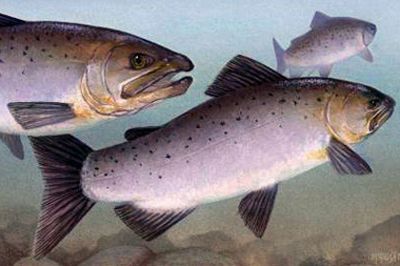Salmon: Agents of Riverbed Erosion

SAN FRANCISCO (ISNS) -- From the massive migrations to mating behavior, scientists have long studied the process of salmon spawning. But researchers are only now starting to identify the contribution that spawning has on the riverbeds in which salmon lay their eggs.
At a meeting of the American Geophysical Union this week, Daniele Tonina from the University of Idaho, in Boise, described the significant footprint salmon leave behind on the landscape.
Salmon migrations affect the way sediment moves through the river, said Tonina. "In a certain way they accelerate evolution [of the river]." He compared the erosion caused by each year's salmon run to the rough equivalent of a yearly flood, such as the type that follows the spring snowmelt.
Female salmon, sometimes with help from the males, dig two holes in the riverbed. First they dig out an area in which to lay their eggs. Then, after one or more males fertilizes the eggs, the female digs another hole upstream. That material falls over the first hole to bury the eggs. The net result is called a redd, a combination of a hole and hill with a net elevation difference that can reach 18 inches or more. Females can construct several redds during spawning.
As a result, when a massive group of salmon spawns, they don't leave behind a stereotypical smooth river bottom. The post-spawning riverbed is bumpy, like a mogul-dotted ski hill. The salmon also mix together the surface and subsurface sediments. This prevents a process called armoring that ordinarily offers the riverbed some protection against erosion.
Tonina collaborated on the research with Marwan Hassan of the University of British Columbia, in Vancouver. Both have been researching how salmon affect riverbeds for several years. For this project, they focused on the Forfar River, located in British Columbia.
Tonina and Hassan surveyed the river bottom before and after spawning, then constructed mathematical models to help them understand how the changes affected the shear stress, which indicates how much force would be required from the river to initiate further movement of the sediments in the downstream direction.
Sign up for the Live Science daily newsletter now
Get the world’s most fascinating discoveries delivered straight to your inbox.
In a separate meeting presentation, Todd Buxton, also from the University of Idaho, described his research simulating the effects of salmon on stream beds. As part of that effort, he struck the bottom of an artificial, rocky stream bed with a metal spatula in order to mimic the effects of a salmon's fin. He was then able to construct artificial redds and make measurements of water and sediment flow.
Salmon create significant changes to the stream bed, he said. He compared the amount of sediment moved by spawning salmon to the amount of material required to fill the bed of a dump truck, which is about 10 cubic yards.
"It takes the volume contained in four Chinook salmon redds to fill a dump truck load," said Buxton. Other species produce redds with less volume.
There are numerous variables that contribute to stream bed erosion. In order to understand how to improve or restore river habitats, it's important to understand how salmon factor in to that system, said Hamish Moir of cbec eco engineering in the U.K. "Fish can be really important to sediment transport," he said.
Buxton suggested that in places where salmon habitat has been damaged, restoration of that habitat may allow salmon to return to spawn. This, he said, could encourage erosion, deepen the stream bed and possibly help protect homes and property against flood damage.
In previous research, Hassan showed that in some rivers, salmon were responsible for about half the movement of sediment.
Salmon redds typically last "through the winter, but are usually washed away by the first flood, from the snowmelt," said Tonina during his presentation.
Chris Gorski is a writer and editor for Inside Science News Service.
Inside Science News Service is supported by the American Institute of Physics.











